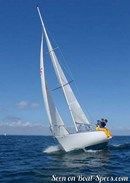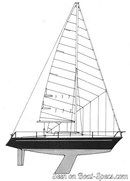Dufour 1300 Fin keel
Sailboat specifications
The Dufour 1300 is a 23’10” (7.26m) racing sailboat designed by Michel Dufour (France). She was built between 1974 and 1975 by Dufour (France). The Fin keel version adopts a classical fin configuration, the easiest option to provide a low center of gravity.
Dufour 1300's main features
- Model
- Dufour 1300
- Version
- Fin keel
- Hull type
- Monohull
- Category
- Racing sailboat
- Sailboat builder
- Sailboat designer
- Sailboat collection
- Country
- France
- Construction
- GRP (glass reinforced polyester):
Sandwich fiberglass polyester - Number of hulls built
- About 60
- First built hull
- 1974
- Last built hull
- 1975
- Appendages
- Keel : fin without bulb
- Helm
- Single tiller
- Rudder
- Single rudder on skeg
- Unsinkable
- No
- Trailerable
- Yes
- Former French navigation category
- 3
- Standard public price ex. VAT (indicative only)
- N/A €
Dufour 1300's main dimensions
- Hull length
- 23’ 10”7.26 m
- Waterline length
- 18’5.5 m
- Beam (width)
- 8’ 8”2.64 m
- Draft
- 4’ 11”1.5 m
- Light displacement (MLC)
- 2866 lb1300 kg
- Ballast weight
- 1257 lb570 kg
- Ballast type
- Cast iron
Dufour 1300's rig and sails
- Upwind sail area
- 316 ft²29.34 m²
- Downwind sail area
- 620 ft²57.58 m²
- Mainsail area
- 104 ft²9.67 m²
- Genoa area
- 212 ft²19.67 m²
- Solent area
- 168 ft²15.6 m²
- Jib area
- 125 ft²11.58 m²
- Symmetric spinnaker area
- 516 ft²47.91 m²
- PiMainsail hoist measurement (from tack to head)
- 24’ 10”7.57 m
- EiMainsail foot measurement (from tack to clew)
- 7’ 7”2.31 m
- Rigging type
- Sloop Marconi masthead
- Mast configuration
- Keel stepped mast
- Rotating spars
- No
- Number of levels of spreaders
- 1
- Spreaders angle
- Swept-back
- Spars construction
- Aluminum spars
- Standing rigging
- 1x19 strand wire continuous
Dufour 1300's performances
- IOR ratingiIOR, or International Offshore Rule, was a measurement rule system used internationally for ocean racing. It allows boats of different sizes and designs to race each other fairly. Therefore, by comparing these values, we can have an indication of the relative speed of 2 boats.
- 18.0
- HN (French rating)iHN or "Handicap Nationale" is an empirical rating system used in France allowing various monohulls, of different sizes and designs, to race each other fairly. It is particularly suitable for cruiser and cruiser-racer. Therefore, by comparing these values, we can have an indication of the relative speed of 2 boats.
- 12.0
- Upwind sail area to displacementiThe ratio sail area to displacement is obtained by dividing the sail area by the boat's displaced volume to the power two-thirds.
The ratio sail area to displacement can be used to compare the relative sail plan of different sailboats no matter what their size.
Upwind: under 18 the ratio indicates a cruise oriented sailboat with limited performances especially in light wind, while over 25 it indicates a fast sailboat. - 265 ft²/T24.63 m²/T
- Downwind sail area to displacementiThe ratio sail area to displacement is obtained by dividing the sail area by the boat's displaced volume to the power two-thirds.
The ratio sail area to displacement can be used to compare the relative sail plan of different sailboats no matter what their size. - 520 ft²/T48.34 m²/T
- Displacement-length ratio (DLR)iThe Displacement Length Ratio (DLR) is a figure that points out the boat's weight compared to its waterline length. The DLR is obtained by dividing the boat's displacement in tons by the cube of one one-hundredth of the waterline length (in feet).
The DLR can be used to compare the relative mass of different sailboats no matter what their length:
a DLR less than 180 is indicative of a really light sailboat (race boat made for planning), while a DLR greater than 300 is indicative of a heavy cruising sailboat. - 221
- Ballast ratioiThe Ballast ratio is an indicator of stability; it is obtained by dividing the boat's displacement by the mass of the ballast. Since the stability depends also of the hull shapes and the position of the center of gravity, only the boats with similar ballast arrangements and hull shapes should be compared.
The higher the ballast ratio is, the greater is the stability. - 44 %
- Critical hull speediAs a ship moves in the water, it creates standing waves that oppose its movement. This effect increases dramatically the resistance when the boat reaches a speed-length ratio (speed-length ratio is the ratio between the speed in knots and the square root of the waterline length in feet) of about 1.2 (corresponding to a Froude Number of 0.35) . This very sharp rise in resistance, between speed-length ratio of 1.2 to 1.5, is insurmountable for heavy sailboats and so becomes an apparent barrier. This leads to the concept of "hull speed".
The hull speed is obtained by multiplying the square root of the waterline length (in feet) by 1.34. - 5.69 knots
Dufour 1300's auxiliary engine
- Engine(s)
- Outboard engine
- Engine(s) power
- 8 HP
- Fuel type
- Gas
Dufour 1300's accommodations and layout
- Cockpit
- Closed aft cockpit
- Berth(s)
- 2
- Maximum headroom
- 4’ 4”1.32 m
Similar sailboats that may interest you:
Sailboats
First built hull
Hull length
1982
23’ 7”7.2 m
1969
25’7.62 m
1982
23’ 7”7.2 m
1983
27’ 7”8.4 m
1971
30’9.14 m
1979
26’7.93 m
1983
28’ 8”8.76 m
1982
25’ 4”7.7 m
1979
24’ 10”7.55 m
1984
25’ 5”7.75 m
1977
27’8.23 m
1974
20’ 4”6.2 m
1978
25’ 11”7.89 m
1978
21’ 6”6.55 m
1978
21’ 7”6.58 m



